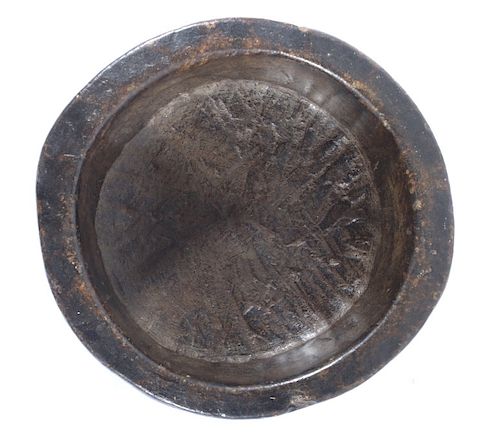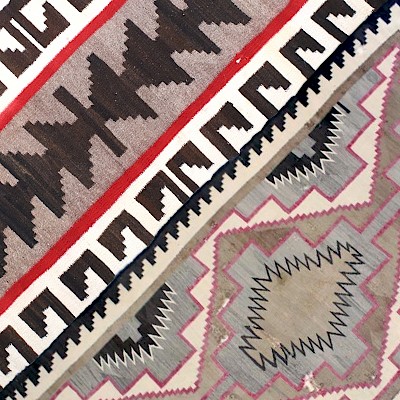Shoshone Steatite Bowl w/ Togia Carvings c. 1860's
Two ways to bid:
- Leave a max absentee bid and the platform will bid on your behalf up to your maximum bid during the live auction.
- Bid live during the auction and your bids will be submitted real-time to the auctioneer.
Bid Increments
| Price | Bid Increment |
|---|---|
| $0 | $5 |
| $50 | $10 |
| $100 | $25 |
| $500 | $50 |
| $1,000 | $100 |
| $2,000 | $250 |
| $5,000 | $500 |
| $10,000 | $1,000 |
| $25,000 | $2,500 |
| $100,000 | $5,000 |
About Auction
Aug 3, 2019
You are invited to our premier August Collector Sale. The sale will include some of our finest American Indian antiques, various classic cars and advertising signs. North American Auction Company tucker@naabid.com
- Lot Description
This is a historic and important steatite stone carved cooking vessel or bowl from the Shoshone Native American Indian people of the 19th Century. The bowl was said to have been made in the 1860's. The bowl was owned by the daughter of Cheyenne Chief Dull Knife, White Woman who was wife to Red Bear. The bowl has been examined and authenticated by renowned historian and Togia language expert, Wendell Grangaard of The Guns of History, Inc. These vessels have been documented as being a rich historic Shoshone Native American Indian tradition as being “inherited by the daughters of the family. If there were no daughters, a son would get the pots, They were property of the family. They were never traded” as stated by anthropologist Demtri Shimkin paraphrased Dick Washakie, son of the Eastern Shoshone Chief Washakie. On the exterior bottom of the bowl the owners name, White Woman is carved, along with the following message: “married – Red Bear – Shoshone – son Crawler – daughter Cheyenne Chief Dull Knife White Woman – daughter Spotted Buffalo Girl – son Plenty Buffalo – White Woman.” The previous carving is shown in illustration 1. On the inside of the bowl written in Togia Lakota Language as shown in Illustration 2 is another message, “White Woman married Red Bear – Four Horse Daughter – son Plenty Buffalo – Shoshone – daughter Cheyenne Chief Very Brave Dull Knife – Spotted Buffalo Girl – son Crawler.” The piece comes with the signed letter describing the piece’s history from Wendell Grangaard along with a detailed illustration showing the markings he has translated. Wendell Grangaard is the foremost knowledge on the Togia language along with the Battle of the Little Bighorn as he is the author of the book, “Documenting the Weapons Used at Little Bighorn” 2015. Wendell was also intricate in the authentication and examination of the historic George Armstrong Custer Captured Sharps Carbine from Chief Black Kettle that sold at auction for $127,000. Comes with documentation including a detailed description authenticating the piece signed by Wendell, along with a illustration showing the togia language carvings drawn. Other documentation includes “The Greater Yellowstone Ecosystem, soapstone bowls and the Mountain Shoshone: by Richard Adams. Accompanied by the bowl is the original museum tag from the Sioux Nation Historical Museum of Sioux Falls, South Dakota from curator Douglas Vernon. Also accompanying this lot is the book “Storied Stone: Indian Rock Art of the Black Hills Country” by Linea Sundstrom from 2004 University of Oklahoma Press. In the book on page 42 it states, “The Oglala holy man Nickolas Black Elk told of Lakota use of rock art in the Black Hills: “There is a place in the Black Hills, also on the Little Big Horn, a bank of solid rock where there are inscriptions that only a medicine man can read. It is a mystery…” Also on page 69 and page 179 are depictions of typical phosphene or entopic designs that match the symbols documented to be found in the rock art of the Black Hills. Many if not all of these symbols that are shown and documented to be authentic uses of Lakota language were also passed down to Wendell Grangaard. This book virtually confirms the authentic documentation of these togia language carvings in the historic rock carvings of the Lakota Sioux in Wyoming, South Dakota and Montana. Early Native American Indian Steatite bowls with no documentation or carvings are still of a highly collectible nature with some examples selling at auction such as the California Coastal bowl that sold for $3,000 and was valued at $8,000 in 2014. This bowl carrys a much more important historic and collectible value as it has been documented to have been carved by a Cheyenne and Shoshone woman. Measures overall 5.75”x5.5” and 2” thick. The bowl was informally appraised by Grangaard at over $20,000.For a complete representation of condition and for additional images please call 800-686-4216. It is the buyer’s responsibility to view each image and preview the item to determine condition.
Condition
- Shipping Info
-
North American Auction Company is proud to announce the opening of our new in-house, full-service shipping department. We have listened to you the customer and will now be handling all outgoing packages in our new shipping department. We are confident this new offering will allow for a smooth transition from auction block to your front step. We have partnered with preferred carriers to ensure a safe, efficient delivery that works best with your schedule. Please allow 14-21 days after complete invoice payment is made to package and ship your purchase. After you are notified of your winning bids from our company and your item invoice is paid in full our new shipping department will contact you. Make sure when signing up with our company that your preferred shipping information is up to date as this information will be used to estimate shipping cost. Once the items have been packaged our team will contact you for shipping payment. Shipping invoices and payment will be completely separately than the items invoice. Please notify the shipping department with any alternate request or instructions at mark@northamericanauctioncompany.com or 800-686-4216 ext. 3. For a shipping quote please contact the same information above. PLEASE NOTE a shipping quote price can fluctuate in price. Auction company is not responsible for actual shipping cost being higher than quoted shipping cost. Thank you for trusting North American Auction Co. with your bids and shipping. As our shipping department is brand new please understand that delays can be expected.
-
- Buyer's Premium



 EUR
EUR CAD
CAD AUD
AUD GBP
GBP MXN
MXN HKD
HKD CNY
CNY MYR
MYR SEK
SEK SGD
SGD CHF
CHF THB
THB




























